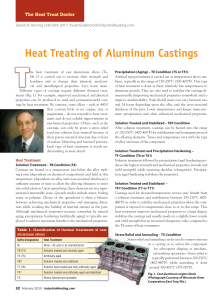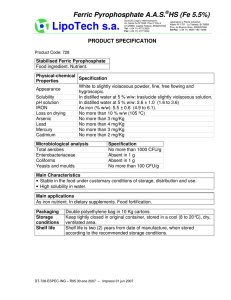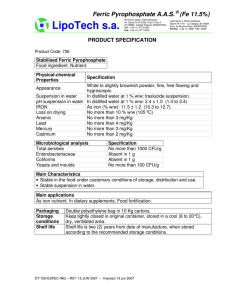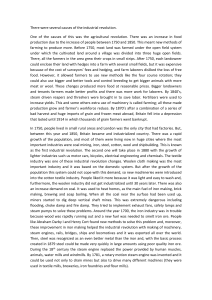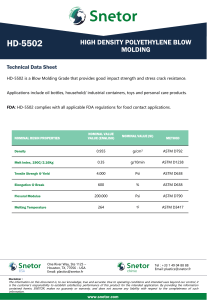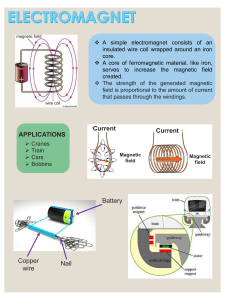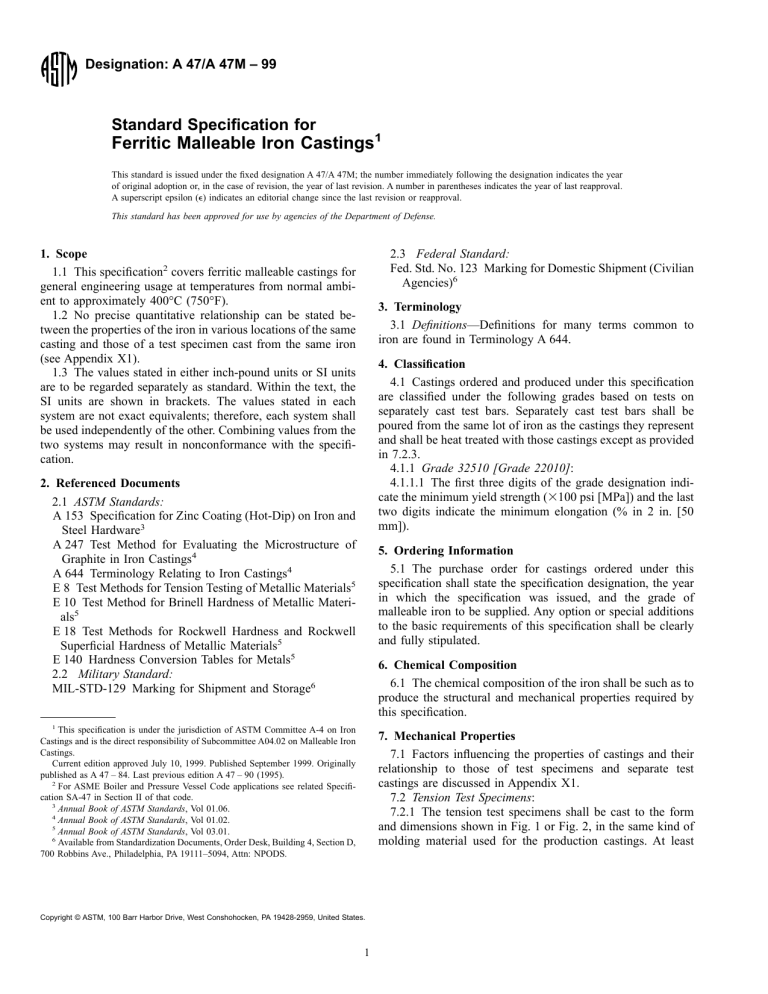
Designation: A 47/A 47M – 99 Standard Specification for Ferritic Malleable Iron Castings1 This standard is issued under the fixed designation A 47/A 47M; the number immediately following the designation indicates the year of original adoption or, in the case of revision, the year of last revision. A number in parentheses indicates the year of last reapproval. A superscript epsilon (e) indicates an editorial change since the last revision or reapproval. This standard has been approved for use by agencies of the Department of Defense. 1. Scope 1.1 This specification2 covers ferritic malleable castings for general engineering usage at temperatures from normal ambient to approximately 400°C (750°F). 1.2 No precise quantitative relationship can be stated between the properties of the iron in various locations of the same casting and those of a test specimen cast from the same iron (see Appendix X1). 1.3 The values stated in either inch-pound units or SI units are to be regarded separately as standard. Within the text, the SI units are shown in brackets. The values stated in each system are not exact equivalents; therefore, each system shall be used independently of the other. Combining values from the two systems may result in nonconformance with the specification. 2.3 Federal Standard: Fed. Std. No. 123 Marking for Domestic Shipment (Civilian Agencies)6 3. Terminology 3.1 Definitions—Definitions for many terms common to iron are found in Terminology A 644. 4. Classification 4.1 Castings ordered and produced under this specification are classified under the following grades based on tests on separately cast test bars. Separately cast test bars shall be poured from the same lot of iron as the castings they represent and shall be heat treated with those castings except as provided in 7.2.3. 4.1.1 Grade 32510 [Grade 22010]: 4.1.1.1 The first three digits of the grade designation indicate the minimum yield strength (3100 psi [MPa]) and the last two digits indicate the minimum elongation (% in 2 in. [50 mm]). 2. Referenced Documents 2.1 ASTM Standards: A 153 Specification for Zinc Coating (Hot-Dip) on Iron and Steel Hardware3 A 247 Test Method for Evaluating the Microstructure of Graphite in Iron Castings4 A 644 Terminology Relating to Iron Castings4 E 8 Test Methods for Tension Testing of Metallic Materials5 E 10 Test Method for Brinell Hardness of Metallic Materials5 E 18 Test Methods for Rockwell Hardness and Rockwell Superficial Hardness of Metallic Materials5 E 140 Hardness Conversion Tables for Metals5 2.2 Military Standard: MIL-STD-129 Marking for Shipment and Storage6 5. Ordering Information 5.1 The purchase order for castings ordered under this specification shall state the specification designation, the year in which the specification was issued, and the grade of malleable iron to be supplied. Any option or special additions to the basic requirements of this specification shall be clearly and fully stipulated. 6. Chemical Composition 6.1 The chemical composition of the iron shall be such as to produce the structural and mechanical properties required by this specification. 1 This specification is under the jurisdiction of ASTM Committee A-4 on Iron Castings and is the direct responsibility of Subcommittee A04.02 on Malleable Iron Castings. Current edition approved July 10, 1999. Published September 1999. Originally published as A 47 – 84. Last previous edition A 47 – 90 (1995). 2 For ASME Boiler and Pressure Vessel Code applications see related Specification SA-47 in Section II of that code. 3 Annual Book of ASTM Standards, Vol 01.06. 4 Annual Book of ASTM Standards, Vol 01.02. 5 Annual Book of ASTM Standards, Vol 03.01. 6 Available from Standardization Documents, Order Desk, Building 4, Section D, 700 Robbins Ave., Philadelphia, PA 19111–5094, Attn: NPODS. 7. Mechanical Properties 7.1 Factors influencing the properties of castings and their relationship to those of test specimens and separate test castings are discussed in Appendix X1. 7.2 Tension Test Specimens: 7.2.1 The tension test specimens shall be cast to the form and dimensions shown in Fig. 1 or Fig. 2, in the same kind of molding material used for the production castings. At least Copyright © ASTM, 100 Barr Harbor Drive, West Conshohocken, PA 19428-2959, United States. 1 A 47/A 47M FIG. 1 Tension Test Specimen NOTE 1—The gage length and fillets shall be as shown, but the ends may be of any shape to fit the holders of the testing machine in such a way that the load shall be axial. The reduced section shall have a gradual taper from the ends toward the center, with the ends 0.003 to 0.005 in. [0.08 to 0.13 mm] larger in diameter than the center. NOTE 1—Modifications may be made in the dimensions indicated above for those details of the specimen outside of the gage length as required by testing procedure and equipment. FIG. 2 Alternative Unmachined Tension Test Specimen FIG. 3 Machined Tension Test Specimen three such specimens shall be cast from a representative ladle of iron either from each batch-melted heat or, in continuous melting, from each 4-h pour period during which the purchaser’s castings were poured, or as otherwise agreed upon between manufacturer and purchaser. 7.2.2 All test specimens shall be suitably identified with the designation of either the batch-melted heat or the pour period of a continuous heat. 7.2.3 All test specimens shall be heat treated in the same production furnaces and in the same cycles as the castings they represent. However, in those instances wherein the critical sections of the production castings differ appreciably from that of the central portion of the test specimens, the time cycle for tempering the test specimens may be altered from that of the production lot in order to obtain similar microstructures or hardness, or both, in both specimen and castings. In such cases the hardness of the specimens shall be tested and reported along with the tensile test results. 7.2.4 The tension test is usually performed on unmachined specimens. However, for referee work, the specimen may be machined from the standard cast bar to the dimensions shown in Fig. 3. 7.3 Tension Test Method: 7.3.1 The gage length of the standard tension specimen shall be 2.00 6 0.01 in. [50.0 6 0.3 mm]. 7.3.2 The diameter used to compute the cross-sectional area shall be the average between the largest and smallest diameters in that section of the 2-in. [50-mm] gage length having the smallest diameter and shall be measured to the nearest 0.001 in. [0.2 mm]. No cast bar having a mean diameter less than 0.590 in. [15.0 mm] shall be accepted for test. 7.3.3 After reaching a stress equivalent to approximately half of the anticipated yield stress, the speed of the moving head of the testing machine shall not exceed 0.50 in./min [12.5 mm/min] through the breaking load. 7.3.4 While the values for yield point and yield strength are not identical, they are sufficiently close for most applications of ferritic malleable irons to be used interchangeably. They may be determined by any of the approved techniques described in the paragraphs on Determination of Yield Strength and Yield Point of Test Methods E 8. If determined as yield strength, that stress producing an extension under load of 0.01 in. [0.25 mm] over the 2-in. [50-mm] gage length (for example, 0.5 % extension) or an offset of 0.2 % shall be taken as the yield stress, which shall be converted to yield strength by dividing by the original cross-sectional area of the gage length found in accordance with 7.3.2. It shall be reported to the nearest 100 psi [MPa]. In referee work, yield strength shall be determined as the stress that produces an extension under load of 0.5 % of the gage length. 7.3.5 The tensile strength shall be the maximum load carried by the specimen during the test divided by the original cross-sectional area of the gage length, as found in accordance with 7.3.2. It shall be reported to the nearest 100 psi [MPa]. 7.3.6 The elongation is the increase in gage length after fracture of a tensile specimen, measured to the nearest 0.01 in. [0.25 mm], expressed as a percentage of the original gage length. It shall be reported to the nearest 0.5 %. 7.4 Retesting: 7.4.1 If, after testing, a specimen shows evidence of a defect, another tension test may be made on a companion specimen. Also, a retest shall be permitted whenever fracture occurs outside the central 50 % of the gage length. 7.4.2 If the results of a valid test fail to conform to the requirements of this specification, two retests shall be made. If either retest fails to meet the specification, the castings represented by these test specimens shall be rejected. A valid test is 2 A 47/A 47M cast irons, are approximate only and, therefore, are generally inadvisable. 7.5.3 Sufficient material shall be removed from the cast surface to ensure that the measured surface is representative. 7.5.4 Sampling procedures and the frequency of hardness testing shall be fully detailed on the purchase agreement. Otherwise, hardness tests shall be performed at the discretion of the producer. 7.5.5 Castings failing to conform to the required hardness range may be reheat treated and retested. If after reheat treating they still fail the hardness requirements, they shall be rejected. 7.5.6 Typical hardness maximums for this grade of malleable iron are listed in Table 2. one wherein the test specimen has been properly prepared and appears to be sound and on which the approved test procedure has been followed. 7.4.3 If sufficient companion test bars are unavailable, the manufacturer shall have the option of testing a specimen cut from a representative casting. Therefore, as stated in X1.3, the mechanical properties of such tension test specimen removed from a production casting will not necessarily correspond to those of a standard separately cast test specimen, the values in Table 1 do not apply. Instead, the mechanical properties of the test specimen from the casting must equal or exceed the average of those from similar test specimens removed from the same location from two castings of the same design where separately cast test bars meet the requirements of Table 1. 7.4.4 If the first test results indicate that a reheat treatment is needed to meet the test requirements, the entire lot of castings and the representative test specimens shall be reheat treated together. Testing shall then be repeated in accordance with 7.4.1-7.4.3. 7.4.5 The results of all tests, including retests, shall be posted in permanent record, which shall state any abnormalities observed during the test and in the fractured ends. Such records shall be kept for at least 1 year after shipment of the production castings and shall be available for examination by the purchaser or by his authorized representative. 7.4.6 If not covered in the purchase agreement, the frequency of tension testing shall be in accordance with 7.2.1 and sufficiently often to ensure uniformity of product and compliance with minimum test requirements. 7.4.7 Tension test results, obtained in accordance with the above subsections, must conform to the values of Table 1 for acceptance under this specification except as provided in 7.4.3. 7.4.8 When agreed upon between manufacturer and purchaser, tested specimens or unbroken test bars shall be preserved by the manufacturer for a period of three months after the date of the test report. 7.5 Hardness Test—If the purchase agreement requires hardness testing, the acceptable hardness range shall be stated and a test location clearly shown on the covering drawing(s). 7.5.1 Hardness Test Method—The Brinell method of hardness testing in accordance with Test Method E 10 shall be employed whenever possible. 7.5.2 For castings of such size or shape that do not permit Brinell testing with the standard 3000-kgf load, the 500 kgf may be employed, the hardness number being reported as HB 10/500/15. In very unusual cases where it is impossible to use the Brinell method, the Rockwell test may be substituted, using Test Methods E 18 with an appropriate Rockwell scale. Conversions of hardness values from one method to another according to Standard E 140, which does not specifically cover 8. Microstructure Requirements 8.1 The microstructure of the malleable iron shall consist of temper carbon nodules distributed through a ferritic matrix and shall be free of excessive pearlite, massive carbides, and primary graphite. 8.2 When agreed upon by the purchaser and producer, the maximum decarburization at any as-cast surface after heat treatment may be stipulated in writing, as measured by visual depletion of combined carbon after polishing, etching in nital, and viewing at 1003. 8.3 In reference work, the metallographic practice recommended in Test Method A 247 shall be followed. 9. Soundness Requirements 9.1 All castings, on visual examination, shall be sound and free of obvious shrinkage and porosity. 9.2 If the purchaser requires soundness tests to be performed, it shall be so stated in the purchase agreement, and the method and soundness requirements shall be detailed. 10. Dimensional Requirements 10.1 The castings shall conform to the dimensions given on drawings furnished by the purchaser, or to the dimensions established by the pattern equipment supplied by the purchaser, or as agreed upon in specific cases to gages supplied by the purchaser. Variations in any solid dimensions will be permitted, as shown in Table 3, unless otherwise agreed upon by the foundry and purchaser. 11. Workmanship, Finish and Appearance 11.1 The surface of the casting shall be inspected visually, particularly in critical areas, for such surface defects as cracks, hot tears, adhering sand and scale, cold shuts, and gas holes. 11.2 No repairing, plugging, or welding of any kind shall be permitted unless written permission is granted by the purchaser. 11.3 Castings that have been repaired by welding shall be reannealed so that their microstructure will comply with Section 8. TABLE 1 Tension Test Requirements English Grade 32510 Metric Grade 22010 Inch-Pound Grades Tensile Strength, Yield Strength, min, psi min, psi 50 000 32 500 Metric Grades Tensile Strength, Yield Strength min, MPa min, MPa 340 220 Elongation in 2 in, min, % 10 TABLE 2 Typical Hardness Inch-Pound Grade [Metric Grade] 325 10 [22010] Elongation in 50 mm, min, % 10 3 Hardness, maximum HB 156 Indentation Value Diameters, mm 4.8 A 47/A 47M TABLE 3 Permissible Variation in Any Solid Dimension Size, in. [mm] 6 12 18 24 Up to 1 [up to 25] 1 to 6 [25 to 150] to 12 [151 to 300] to 18 [301 to 460] to 24 [461 to 600] to 36 [601 to 900] shipment, stating clearly his basis for rejection. In case of dissatisfaction with the purchaser’s claim, the manufacturer may apply for a hearing before final rejection of the shipment. Tolerance, 6 in. [mm] 0.03 0.06 0.12 0.15 0.19 0.22 [0.8] [1.6] [3.2] [3.8] [4.8] [5.6] 14. Certification 14.1 When specified by the purchaser’s order or contract, a manufacturer’s certification or compliance statement that the casting or lot of castings was made, sampled, tested, and inspected in accordance with this specification, including a report of test results signed by an authorized agent of the manufacturer, shall be furnished at the time of shipment, and such certification or compliance statement shall be the basis for acceptance of the casting or lot of castings. 12. Responsibility for Inspection 12.1 Unless otherwise specified in the contract or purchase order, the manufacturer shall be responsible for carrying out all the tests and inspections required by this specification, using his own or other reliable facilities, and he shall maintain complete records of all such tests and inspections. Such records shall be available for review by the purchaser. 12.2 The purchaser reserves the right to perform any inspection set forth in the specification where such inspections are deemed necessary to ensure that supplies and services conform to the prescribed requirements. 15. Product Marking 15.1 When the size of the casting permits, each casting shall bear the identifying mark of the manufacturer and the part or pattern number at a location shown on the covering drawing and, if not shown on the drawing, at such a location at the discretion of the producer that the identification will not interfere with subsequent processing and service of the casting. 13. Rejection and Rehearing 13.1 Any casting or lot of castings failing to comply with the requirements of this specification may, where possible, be reprocessed, retested, and reinspected. If the tests and inspections on the reprocessed casting(s) show compliance with this specification, the castings shall be acceptable; if they do not, they shall be rejected. 13.2 If the purchaser should find that a casting or lot of castings fails to comply with this specification subsequent to receipt at his facility, he shall so notify the manufacturer promptly and in no case later than six weeks after receipt of the 16. Packaging and Package Marking 16.1 Unless otherwise stated in the contract or order, the cleaning, preservation, and packing of castings for shipment shall be in accordance with the manufacturer’s commercial practice. Packaging and marking shall also be adequate to identify the contents and to ensure acceptance and safe delivery by the carrier for the mode of transportation employed. 16.2 U.S. Government Procurement—When specified in the contract or purchase order, marking for shipment shall be in accordance with the requirements of Fed. Std. No. 123 and MIL-STD-129. SUPPLEMENTARY REQUIREMENTS otherwise broken up, to determine the presence of any manufacturing condition that might be detrimental to the serviceability of the casting. S1. Special Conditions S1.1 If agreed upon in writing by the foundry and purchaser, the malleable iron castings may be required to meet special conditions, hardness or other property dimensions, surface quality, or a combination of conditions. S4. Special Tension Specimens S4.1 If tension specimens are to be machined from castings, their location in the casting, the specimen dimensions, and the required properties shall be agreed upon in writing by the foundry and purchaser. S2. Test Lugs S2.1 If requested in writing or if included on the pattern(s) or pattern drawing(s), test lugs may be cast on all castings of sufficient size to permit their incorporation. The size of such lugs shall be proportional to the thickness of the casting. On castings over 24 in. [600 mm] in length, a test lug shall be cast near each end such as not to interfere with any subsequent processing of the castings. The purchase order shall stipulate whether the foundry’s inspector or the purchaser’s inspector shall break, inspect, and pass judgment on the fracture quality of these test lugs. S5. Zinc-Coated Castings S5.1 When specified in the contract or purchase order, castings shall be zinc-coated by the hot-dip process in accordance with Specification A 153. Castings shall be of a composition that will preclude the possibility of galvanizing embrittlement, or shall be either cooled from the anneal or subsequently heat treated so as to be immunized against such embrittlement. If regalvanizing is required, procedures for regalvanizing castings and determining the effect on the casting performance must be agreed upon between the purchaser and the seller. S3. Destructive Tests S3.1 At the option of the purchaser or his representative, a casting of each design ordered may be tested to destruction, or 4 A 47/A 47M S6. Marking of Casting for Government Procurement S6.1 When castings are specified for government procurement, the location of the permanent markings specified in 15.1, as well as any special marking for mechanical or physical properties (either permanent or temporary), shall be as indicated on the government drawings or sketches. APPENDIX (Nonmandatory Information) X1. MECHANICAL PROPERTIES OF CASTINGS gether with the heat treatment that is inherent in the manufacture of malleable iron, tends to reduce the section-sensitivity effect. Therefore, where experimentation into precise properties within a given casting would be infeasible, this standard test bar, made like any typical casting, should provide a practical approximation of the properties that can be expected in average sound malleable iron casting. X1.1 The mechanical properties of malleable iron castings are influenced by a number of factors, including the cooling rate during solidification, chemical composition, the heat treatment, the design of the casting, section thickness, and the location and effectiveness of gates, risers, and chills. X1.2 Because of the complexity of these factors in influencing the properties of the final product, no precise quantitative relationship can be stated between the properties of the iron in various locations of the same casting or between the properties of a casting and those of a test specimen cast from the same iron. When such a relationship is important and must be known for a specific application, it may be determined by appropriate experimentation. X1.4 If malleable iron castings are welded, the microstructure of the iron is markedly affected, particularly in the heat-affected zone. Therefore, since this may adversely affect the properties of the casting, the welding of malleable iron castings should be done under strict metallurgical control, followed by appropriate post-weld heat treatment, to minimize the substantial reductions in ductility, impact resistance, and machinability that could result, particularly in the vicinity of the weldment. Nevertheless, it is generally considered inadvisable to join castings to similar castings or to other materials, by fusion welding out in the field, or in manufactured assemblies, without fully testing the entire completed part. X1.3 The specimen specified in 7.2.1 as the standard tensile test bar for malleable iron has a 5⁄8-in. [16-mm] diameter test section that reasonably represents a typical section of the general run of malleable iron castings. Furthermore, the initial freezing of malleable irons as homogeneous white iron, to- The American Society for Testing and Materials takes no position respecting the validity of any patent rights asserted in connection with any item mentioned in this standard. Users of this standard are expressly advised that determination of the validity of any such patent rights, and the risk of infringement of such rights, are entirely their own responsibility. This standard is subject to revision at any time by the responsible technical committee and must be reviewed every five years and if not revised, either reapproved or withdrawn. Your comments are invited either for revision of this standard or for additional standards and should be addressed to ASTM Headquarters. Your comments will receive careful consideration at a meeting of the responsible technical committee, which you may attend. If you feel that your comments have not received a fair hearing you should make your views known to the ASTM Committee on Standards, 100 Barr Harbor Drive, West Conshohocken, PA 19428. This standard is copyrighted by ASTM, 100 Barr Harbor Drive, West Conshohocken, PA 19428-2959, United States. Individual reprints (single or multiple copies) of this standard may be obtained by contacting ASTM at the above address or at 610-832-9585 (phone), 610-832-9555 (fax), or service@astm.org (e-mail); or through the ASTM website (http://www.astm.org). 5
